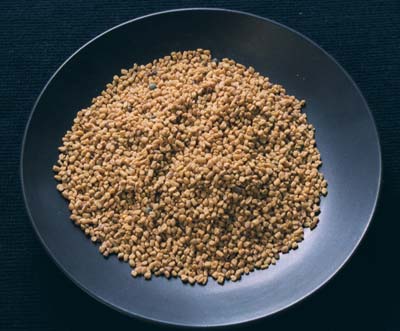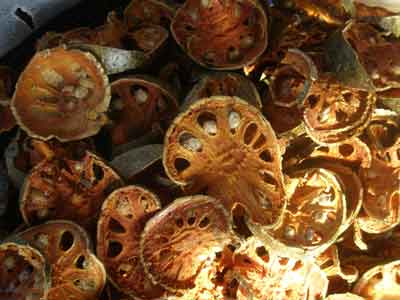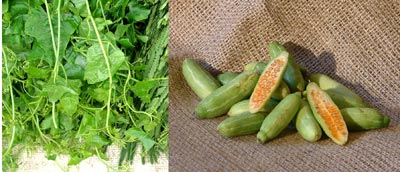
Fenugreek. The seeds impart a distinctive, smoky flavour to dishes. Both the leaves and seeds are used, in the same way as they are for coriander (US: cilantro).
The woodapple or elephant apple is a jungle fruit about the size of an orange from India and Sri Lanka. The shell is hard and woody, not surprisingly, and rough grey in appearance. The best way to get into it, rather as for a coconut, is by throwing it onto a concrete floor. It can be eaten raw or mashed with sugar and water to make into sherbets. The pulp is used, grated, with chilli powder, onions, salt and lime juice to make a sour sambal. It is also known as the elephant apple because elephants are thought to consume the woodapple whole. When their droppings are examined they are found to contain whole shells which, when opened, are found to be empty of their contents. Could it be that the elephant digests the pulp without the shell?

Bael fruit; a close relative of the citrus. The fruit is about the size of, and has the appearance of a greyish-yellow orange with a thin woody rind. The floury pulp is pale orange in colour and has numerous seeds. Dried slices are soaked and boiled and the resulting liquid sweetened and drunk. Used for medicinal purposes.

Bael fruit; a close relative of the citrus. The fruit is about the size of, and has the appearance of a greyish-yellow orange with a thin woody rind. The floury pulp is pale orange in colour and has numerous seeds. Dried slices are soaked and boiled and the resulting liquid sweetened and drunk. Used for medicinal purposes.

Ivy gourd. A small crunchy gourd reminiscent of a gherkin, green ripening to red, popular in the cuisines of India, Thailand, Indonesia and other South East Asian countries. The shoots and leaves can also be eaten.

Ivy gourd. A small crunchy gourd reminiscent of a gherkin, green ripening to red, popular in the cuisines of India, Thailand, Indonesia and other South East Asian countries. The shoots and leaves can also be eaten.